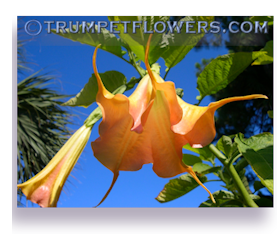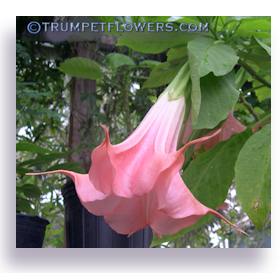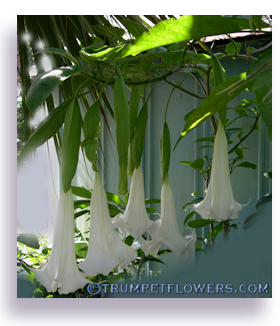Transplanting Your
Plants
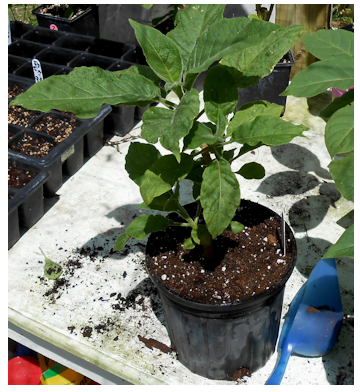 Whenever I transplant my seedlings, saplings, or rooted cuttings of brugmansia, I make sure to do it in early morning, before 9:00. Here, 9:00AM is when the sun begins to peek her head over the horizon's shrubbery and other greenery. Plants in general, don't like their roots exposed to sunlight. Always try to pick a shady spot to do this in.
Whenever I transplant my seedlings, saplings, or rooted cuttings of brugmansia, I make sure to do it in early morning, before 9:00. Here, 9:00AM is when the sun begins to peek her head over the horizon's shrubbery and other greenery. Plants in general, don't like their roots exposed to sunlight. Always try to pick a shady spot to do this in.
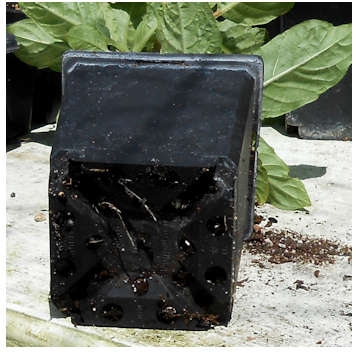 Before you begin, be sure that their root system has already begun to peek out of the bottom of the pot you already have it in. This ensures that the rootball is large enough to hold itself together when lifting out of the old pot and placing it in the new pot. You can loosen it from the original pot by gently banging the sides of it. Do this all the way around. You can turn it on it's side to do this if a pot. If a flat, pick it up and down and gently bang it on a flat surface.
Before you begin, be sure that their root system has already begun to peek out of the bottom of the pot you already have it in. This ensures that the rootball is large enough to hold itself together when lifting out of the old pot and placing it in the new pot. You can loosen it from the original pot by gently banging the sides of it. Do this all the way around. You can turn it on it's side to do this if a pot. If a flat, pick it up and down and gently bang it on a flat surface.
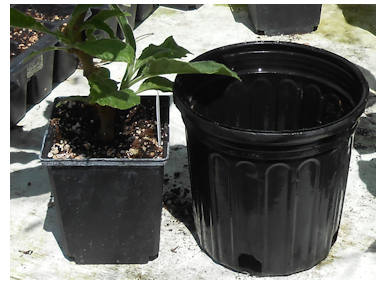 If it is completely rootbound you will need to cut the roots, or unwind them somewhat, whichever your pleasure. If you don't do this step, your plant can have stunted growth, or no growth at all. Plant's roots left in circular shape do not allow them to go anywhere. They won't grow right, and become susceptible to fungus and other pests.
If it is completely rootbound you will need to cut the roots, or unwind them somewhat, whichever your pleasure. If you don't do this step, your plant can have stunted growth, or no growth at all. Plant's roots left in circular shape do not allow them to go anywhere. They won't grow right, and become susceptible to fungus and other pests.
Choose a pot size that is only one or two up from the original. Plant's also won't put out top growth until their roots have filled in the new pot. Choosing one too large will have the plant continually forming roots, but not making stems, leaves and flowers.
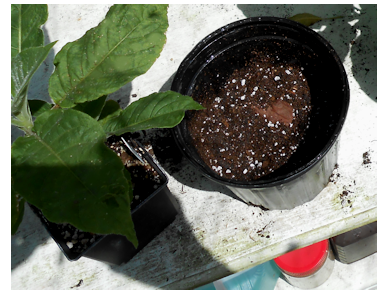 After you have the little plant removed from original pot, make an eye judgment as to how much soil to place in the bottom of the new planter, and fill to that height. Place new plant into center of pot, making sure the soil height remains the same as it was. Then fill in with new soil all around the plant, making sure to lightly pack the soil so there are no large air pockets. Roots cannot grow if touching air, and if too many are exposed to this the plant will suffer.
After you have the little plant removed from original pot, make an eye judgment as to how much soil to place in the bottom of the new planter, and fill to that height. Place new plant into center of pot, making sure the soil height remains the same as it was. Then fill in with new soil all around the plant, making sure to lightly pack the soil so there are no large air pockets. Roots cannot grow if touching air, and if too many are exposed to this the plant will suffer.
Heat is also an enemy of tender new roots. Try to choose a string of 7 or 8 days that will be cooler than 90° in the day, and around 72° nights. This will give your little plants a chance to adapt to their new pots without the stress of heat.
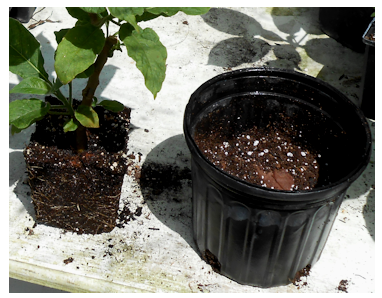 You will need to keep the transplants in a shady, cool area, away from intense sun. And using SuperThrive added to the to water will help them progress much faster, and build a stronger root system. You can use it as directed on the label.
You will need to keep the transplants in a shady, cool area, away from intense sun. And using SuperThrive added to the to water will help them progress much faster, and build a stronger root system. You can use it as directed on the label.
Don't over-fertilize your new plants. It can potentially burn the tender new feeder roots. Wait a week or so until you see the plants begin to perk up and flourish once again, before adding fertilizer. And the first few times, cut the ratio in half of what the package prescribes.
As the plant begins to recover and you can see new top growth, move it slowly into more sunlight. Continue doing this until your plant has just the right amount prescribed for what species or cultivar it is.
Tags: transplanting garden plants, transplant garden plants, transplant small plants,


